As a beginner guitarist, coming up with chord progressions all on your own can be tricky. And while it’s always good to be creative and play around, knowing some common chord progressions can give you a powerful tool to understand the structure of some of the most popular songs while also giving you the ability to apply them in your own songwriting.
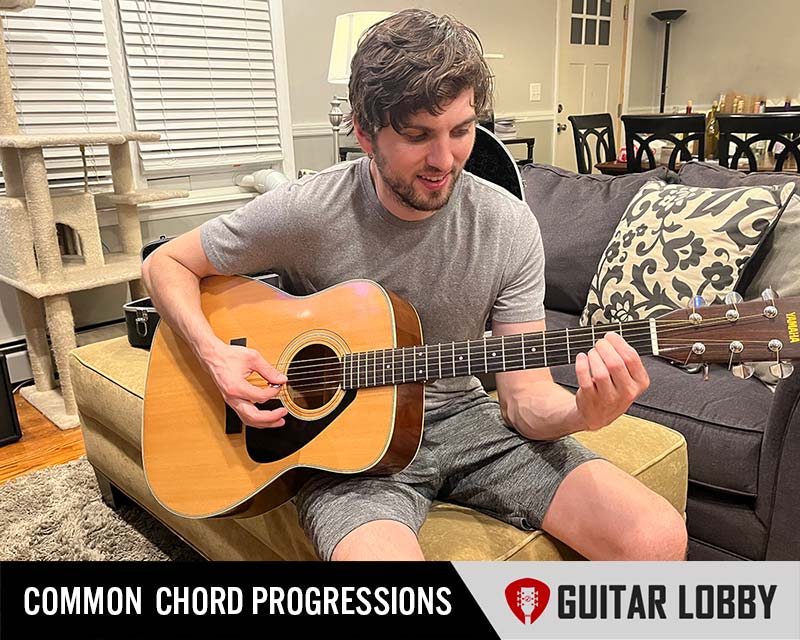
That’s why we’re about to share many easy chord progressions that’ll help you add hundreds and hundreds of songs to your repertoire. But before that, here’s a quick rundown on the theory around progressions to help you make more sense of what’s to follow.
Guitar Chord Progression 101
In its simplest form, a chord progression is the foundation of a song. It is a particular sequence of chords, usually in the same scale or key, played to give the song a meaningful direction. For instance, in C major scale, the notes are C, D, E, F, G, A, B, and C. These seven notes are assigned Roman numerals in this format: I – ii – iii – IV – V – vi – vii. This is also known as the Nashville Numbering System. It helps figure out the scale degree on which a chord is based. You can see there’s a mix of uppercase and lowercase letters. The uppercase stand for major chords, while lowercase is minor.
The I is the root note, and a major chord is made up of the I, III, and V notes, whereas a minor chord is made up of the I, IV, and V notes. We name the chord after the root note. So in a C chord, the root note of the chord is a C. So as we discussed above, a C major chord will include the root note C, the III, an E note, and the IV, a G note. So in a chord progression, we typically start with the root chord. It’s also the tonic chord and tells you which key you’re in and whether it’s minor or major. If the root chord is C, then you’re in C major.
Many instructors out there will tell you that the chord progression consists of chords in the same scale, but that’s not always the case. However, for the sake of simplicity, a majority of popular music features chord progressions on the same scale. As you build your chord vocabulary with time, you will learn to draw outside the lines and ‘borrow’ interesting chords from other scales or keys that work for you!
List of Easy Chord Progressions for Beginners
1. C – G – Am – F Progression I – V – vi – IV
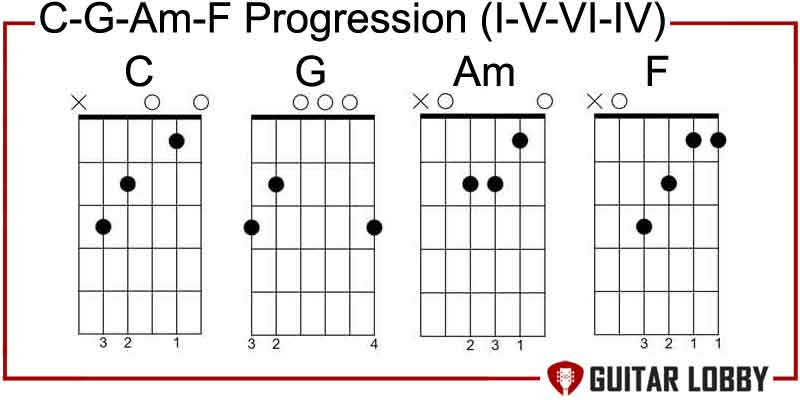
Imagine this: A chord progression that lets you play thousands of the catchiest records in the history of music. Wouldn’t you want to learn it right away? Well, this is it. The I – V – vi – IV progression has been favored by music icons throughout the decades for its ability to boost the energy levels of a song. Why? I think it’s got something to do with the fantastic contrasting sound that comes off from the four chords being the opposites of each other. The C-G-Am-F progression is also incredibly diverse, driving somber pieces like Bob Marley’s “No Woman No Cry” and Adele’s “Someone Like You” to straight-up punk rock on Green Day’s “When I Come Around.”
It’s amazing how many tunes you’ll be able to add to your repertoire by simply learning this progression. If you need more proof of its versatility, just check out Axis of Awesome’s “Four Chord Song.” The Aussie comedy musical trio churns out 36 famous songs in a medley using the same chord progression as this one.
While learning this progression, try playing each chord four times and then pacing yourself. Add it to your daily practice routine to master the switching even at a faster tempo. Remember, not all the songs will be in the same key. I recommend getting yourself a capo to jam along with the original records, no matter the key. If you’re looking for easy guitar chord progressions, this is a great one to try.
Popular Songs That Use This Progression: “Beast of Burden” (The Rolling Stones), “I’m Yours” (Jason Mraz), “Hey Soul Sister” (Train).
2. G – C – D Progression I – IV – V
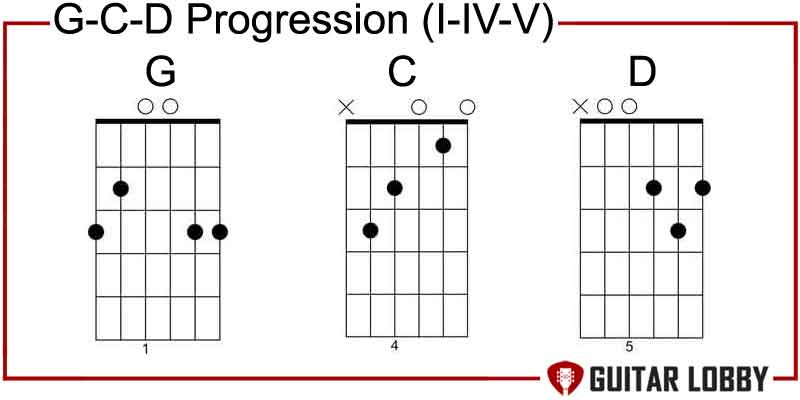
As a beginner, you might have already learned the conventional way to play the G major, C major, and D major chords separately. It’s now time to bring them together to form one of the most popular chord progressions ever. Perfecting the I – IV – V progression will allow you to play thousands of tunes across genres, including blues, rock, and folk.
If you’ve already mastered the standard version of these three open chords, it should be pretty straightforward, right? Well, not exactly. I am not saying that the progression is out of the beginner’s zone, but switching from one chord to another can get pretty tricky. However, by making a few tweaks, you can make the transition much smoother.
The conventional G chord is played by placing the tip of the middle finger on the third fret on the thickest E or sixth string, the first finger on the second fret of the fifth string, and the ring finger on the third fret of the first string. But if you move the ring finger up to the second string third fret and put your pinky on the first string third fret, this will make switching to the C major chord much quicker and easier. Because now, all you need is to move the first and middle fingers down while keeping the others in the same position. Now complete the transition by keeping your third finger in its position and moving the others to form a D chord.
You’ll notice the chord voicings to be slightly different in this arrangement, and also, the alternate arrangement of the C chord here is actually Cadd9. But don’t worry. You won’t be playing this chord progression any different than what bands and musicians have been doing for years.
Popular Songs That Use This Progression: “Sweet Home Alabama” (Lynyrd Skynyrd), “Leaving on a Jet Plane” (John Denver), “Brown Eyed Girl” (Van Morrisson).
3. C – Am – F – G Progression I – vi – IV – V
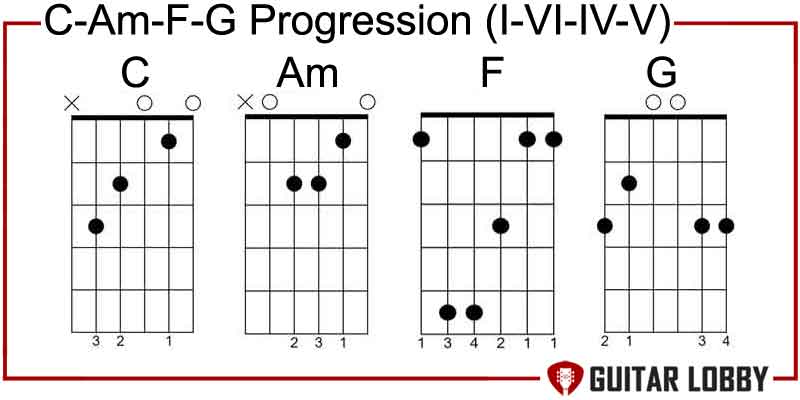
This chord progression is also known as the ‘50s progression for being widely used in the 1950s and the early 1960s. The cyclical progression also became a permanent feature in doo-wop music – an R&B genre known for its group harmonies and melodic rhythms. If I were to apply it to the C major scale, the I – vi – IV – V formula would look like C – Am- F – G.
It’s one of the simplest progressions where all you need are four basic chords based on an easy scale. If you use this Nashville Numbering on another scale, say G major, the sequence would then become G – D – Em – C – an equally popular progression that I’ll get into in a bit. While playing the Doo-wop, it’s important to emulate the track’s steady rhythm. You could begin with quarter notes. Another trick to simplify this progression is by swapping the F barre chord with the Fmaj7.
All in all a recognizable sequence that’ll allow you to play tons of classic tunes. To sample how amazingly well the doo-wop progression sounds in the dreamy vocal ballads of the ‘50s and ‘60s, check out the list of songs below.
Popular Songs That Use This Progression: “Blue Moon” (Elvis Presley), “All I Have to Do is Dream” (The Evelyn Brothers), “Lonely This Christmas” (Mud).
4. Am – F – C – G Progression i – VI – III – VII
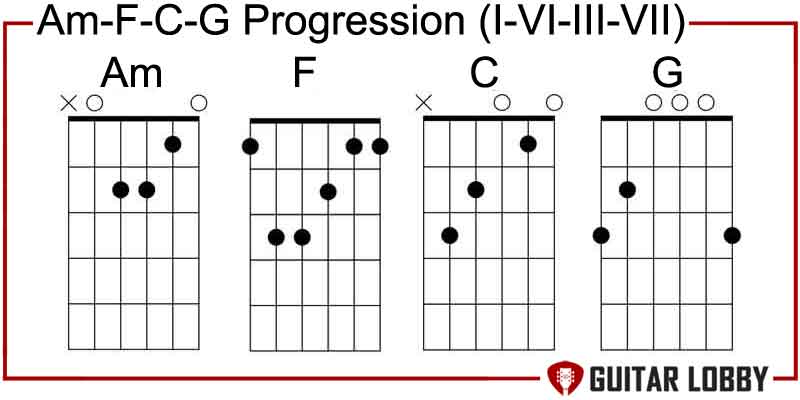
Am-F-C-G is another chord progression that’s a must-learn to build a good chord progression vocabulary. It follows the i – VI – III – VII formula, kicking off with a minor chord, unlike the others on the list so far. This chord progression can also be seen as vi – IV – I – V, where A minor is the vi chord if the song is in the key of C major.
If the track you’ve picked uses this as the main chord progression, then i – VI – III – VII would be more accurate than if it were just one chord progression in a bigger progression in a major key.
The sequence begins with a minor chord, but the three major chords that follow it add versatility. You’ll find this progression in soft ballads like “Apologize” by One Republic to catchy pop earworms such as “Cheap Thrills” by Sia. Playing the F major as a barre chord might feel daunting. In that case, just put the first finger on the second string first fret and use the ring and pinky finger to play the fifth and fourth strings of the third fret. This way, you’ll avoid playing the scary F chord and transition smoothly to the C chord.
It’s fascinating how Am – F – C – G doesn’t sound like C – G – Am – F despite having the same chords and being structured in the same order. There’s a difference in the overall vibe because one is set in a minor key while the other begins with a major key.
Popular Songs That Use This Progression: “Save Tonight” (Eagle Eye Cherry), “21 Guns” (Green Day), “Fall For Youl” (Second Hand Serenade).
5. C – Am – Dm – G Progression I – vi – ii – V
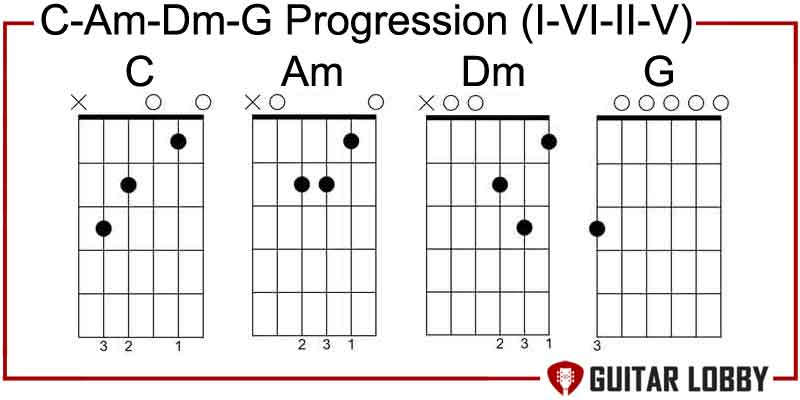
The I – vi – ii – V is a beautiful progression found in many jazz compositions and contemplative ballads. The presence of two minor chords is effective at stirring up the listener’s emotions. The most popular example of this progression is C-Am-Dm-G. When you play it, you’ll notice a change in tonality with each transition, starting with C major to A minor.
It’s also the most common chord progression that utilizes the circle of fifths rule. The circle of fifths is a musical theoretical concept widely used by legends like Bach, Handel, and Vivaldi in their compositions. Being a part of many iconic classical pieces has attuned Western ears to the harmonically strong fifths progressions. You can find this chord sequence in action in the tracks below. If you’re looking for common chord progressions, this is an excellent one to learn.
Popular Songs That Use This Progression: “Hungry Heart” (Bruce Springsteen), “Sherry” (The Four Seasons), “Have Yourself a Merry Little Christmas” (Judy Garland).
6. C – F Progression I – IV
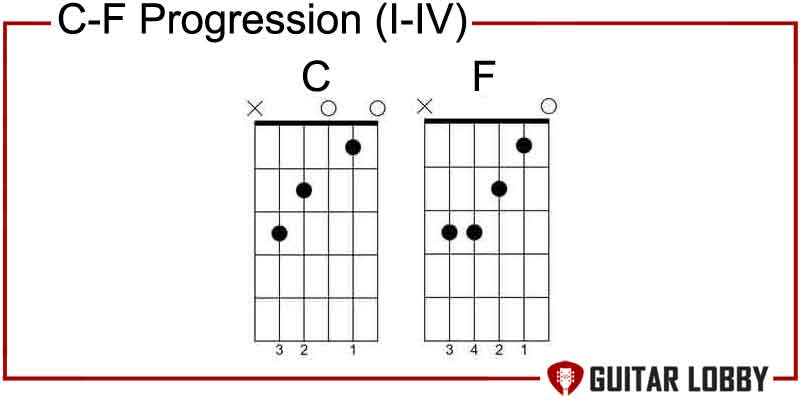
When it comes to songwriting, the two-chord progression of I – IV is incredibly common. Most two-chord songs pair chord I with either chord IV or V. It’s because IV-I and V-I are pretty powerful cadences. What is a cadence? In music theory, a cadence is a two-chord progression that completes the phrase. In the key of C, the Roman numeral I would be the C major chord. We’ll then count four notes to arrive at the IV chord, the F major chord in this case.
Now to play the progression in its entirety, you can try strumming the C chord four times and do the same for the F chord and then repeat the whole thing. Two-chord progressions like these don’t usually power the whole song, though there are some strictly two-chord wonders like “Feeling Alright” by Joe Crocker and “I’ll Take You There” by The Staple Singers. However, in most cases, you’ll find them in specific parts, such as in “Imagine” by John Lenon or the intro of “Like a Rolling Stone” by Bob Dylan.
If you pick something in the key of G, the chord progression would become G-C. You can hear the G-C sequence in catchy anthems like “Love Me Do” by the legendary Beatles and “Jambalaya” by country pioneer Hank Williams.
Popular Songs That Use This Progression: “Like A Rolling Stone” (Bob Dylan) and “Imagine” (The Beatles).
7. C – F – G Progression I – IV – V
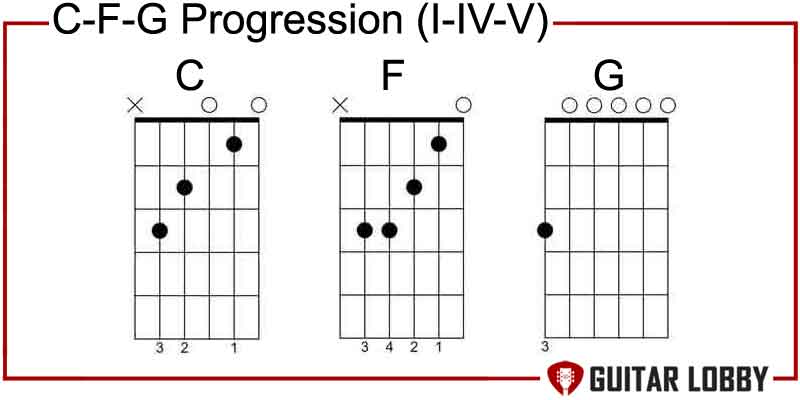
The I – IV – V makes another appearance on this list, this time in the key of C major as the ubiquitous C – F – G progression. This particular chord progression is the cornerstone of blues but has dominated every genre, from rock ‘n’ roll to pop. Though there are some iconic tunes built on just two chords of C-F, they are few and far between. Just by adding a third chord in the form of G major, you can add more movement and access a vast number of famous songs across genres.
The V chord’s resolve to return to the I chord makes the entire progression natural and pleasing to the ears. In most songs, a three-chord progression like this is played as I – IV – V – V, where the V chord is repeated for another bar. It makes more sense this way, sonically, as chord progressions go in 2 bars, 4 bars, 8 bars, or even 12 bars.
Once you’re through mastering this progression, why not try learning it in the key of A major? I am talking about the A-D-E progression that gives C-F-G close competition in popularity. It’s also easier to learn as it’s made up of only basic open chords.
Popular Songs That Use This Progression: “La Bamba” (Ritchie Valens), “Ring of Fire” (Johnny Cash), “All the Small Things” (Blink 182).
8. Dm – Em Progression iv – v
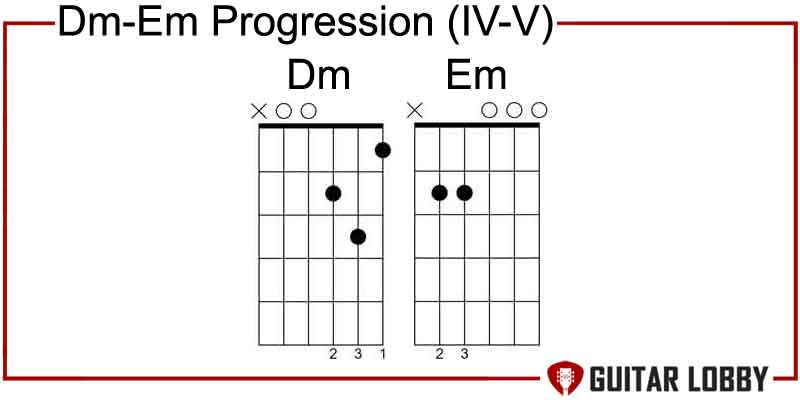
Let’s go back to two-chord progressions for a bit and talk about the iv – v progression. It’s different from the other two-chord progression we discussed, as it comprises only two minor chords. Now, minor chord-only combinations such as this might sound a bit off on their own because neither does the key of D minor have an E minor chord, nor is the vice versa true. But they’re still used by indie or alt-rock bands to add a unique sonic dimension to their tracks. What’s great is that both chords are basic open chords and are easily accessible to beginners.
A perfect and possibly one of the very few examples of this progression I can think of is “505” by the Arctic Monkeys. When you’re ready to practice this progression, start by familiarizing yourself with the D minor and E minor chords individually. Now, try switching between the two. It’s also the thing most beginners struggle with.
Here’s how you can simplify it: After making the Dm chord shape move your first finger to the 5th string and follow it up by moving the second finger over and letting go of the third finger to create the Em chord shape. When moving back to Dm, just follow the steps in reverse. Easy, isn’t it?
Popular Songs That Use This Progression: “505” (Arctic Monkeys).
9. G – D – Em – C Progression I – V – vi – IV
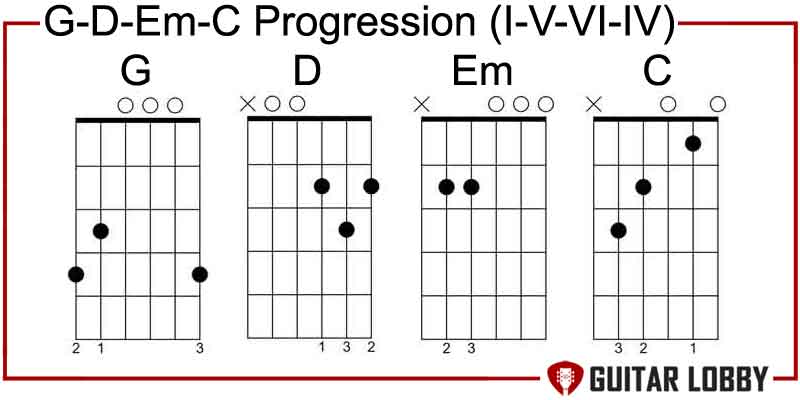
I am not kidding when I say that almost every popular song on earth can be recreated by moving around the G, D, C, and Em chords in different progressions. That’s how versatile these four chords are! Each of these chords is totally beginner-friendly, leaving you to only work on getting a clean transition between them. Now, we’ve seen the I – V – vi – IV progression before in the key of C major. This time, let’s explore it in the key of G, where it looks like G – D – Em – C.
This progression has been around since the ‘50s but peaked in the ‘90s with the pop-punk genre. That’s why it’s also known as the pop-punk progression. I bet there’s be plenty of songs in your repertoire that already use this famous four-chord progression. But just in case there aren’t, I’ve put together a list of tunes below. Go ahead and give them a listen, and you’ll realize this is one of the most common guitar chord progressions in pop and country rock.
Popular Songs That Use This Progression: “With or Without You” (U2), “I’m Yours” (Jason Mraz), “Out of the Woods” (Taylor Swift).
10. 12-Bar Blues Chord Progression I – I – I – I – IV – IV – I – I – V – V – I – I
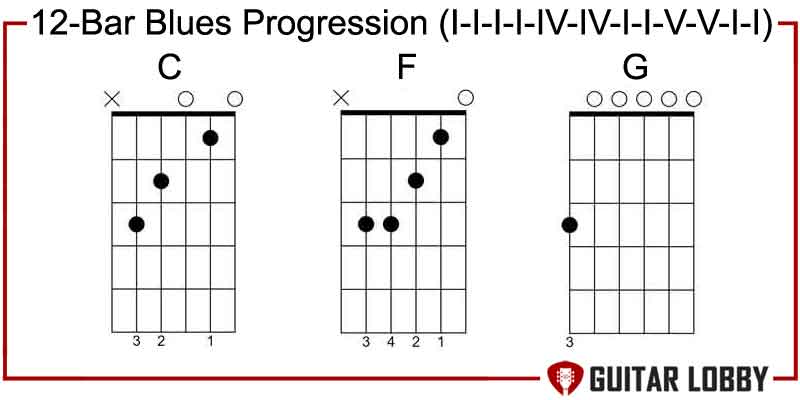
The 12-bar blues might seem complex at first, but it’s an interesting chord progression that every budding guitarist should know. It looks a lot harder than it actually is, and it can be taken on by anyone who’s mastered the I – IV – V progression. In the key of C, a 12-bar blues progression becomes: C-C-C-C-F-F-C-C-G-G-C-C. What it essentially means is that the progression goes on for 12 bars or measures and then repeats itself. A typical 12-bar blues is made up of a tonic chord (C major), a subdominant chord (F major), and a dominant chord (G major).
So, in this case, you’ll begin with four measures of C, followed by two measures of F, then again two measures of C, two measures of G, and finally two measures on the tonic chord or C. If you do the math, then together, they add up to 12 bars. Not just blues, you would notice this progression is widely used in rock as well and is supposedly fantastic for soloing over.
12-bar blues can be played in different keys with fascinating variations. You’ll also need to learn dominant 7th chords to bring a bluesy flavor to your performance. Below are some popular examples of 12 Bar Blues in various keys.
Popular Songs That Use This Progression: “Give Me One Reason” (Tracy Chapman), “Sweet Home Chicago” (Robert Johnson), “Pride and Joy” (Stevie Ray Vaughan).
11. Dm – G – C Progression ii – V – I
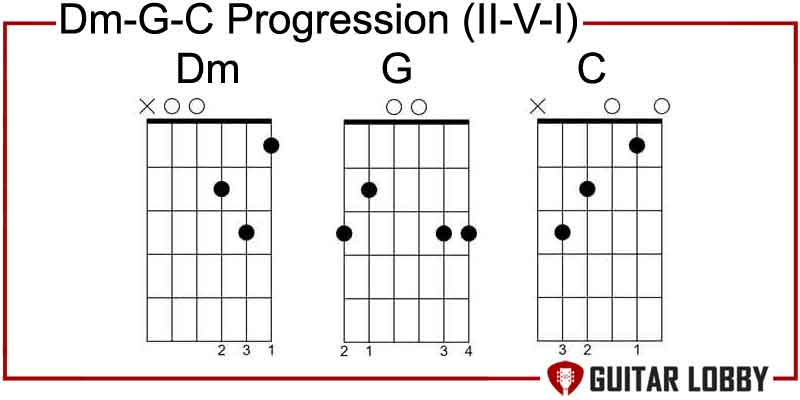
So far, we’ve talked about the ‘50s progression, blues progression, and pop-punk progression. It’s now time to turn our attention to jazz with the ii – V – I chord progression. This one is also called the 2 -5 -1 progression. In the key of C, this progression starts with D minor taking on the role of the ii chord, G major as the V chord, and C major as the I chord. However, in several jazz standards, you’ll find this sequence being played as a ii7-V7-Imaj7. In other words, the ii becomes a minor 7th chord, and I take the form of a major 7th chord or Dm7-G7-Cmaj7.
To play this chord sequence properly, you’ll need to understand the concept of voice leading. In guitar, voice leading is the technique of transitioning from one chord to another with the least possible movement by keeping a melody note consistent or moving through a chord progression.
A good voice leading is particularly important in jazz guitar. I recommend looking up this concept online in more detail before learning this progression. By simply keeping the note E on the top for each of these chords, your progression will become Dm9-G13-Cmaj7 which sounds a lot jazzier than the standard progression.
Though more common in jazz, this progression has spread across genres. Have a look at the examples below and see for yourself.
Popular Songs That Use This Progression: “Satin Doll” (Duke Ellington), “Autumn Leaves” (John Denver), “Boyfriend” (Justin Bieber), and “Bohemian Rhapsody” (Queen).
12. C – F – Am – G Progression I – IV – vi – V
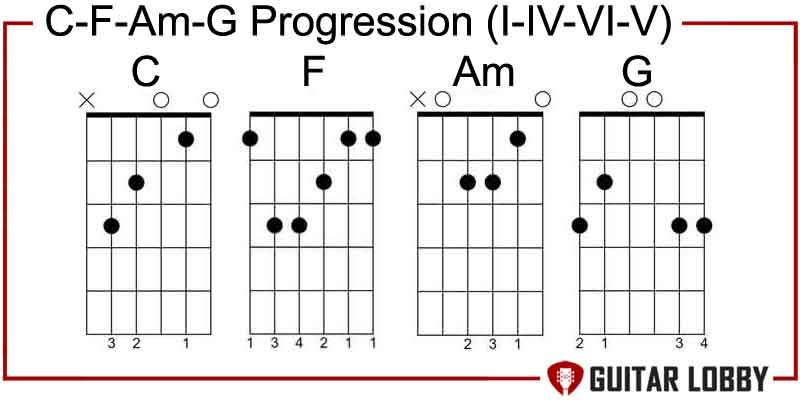
To tell the truth, the I-IV-vi-V sounds similar to the doo-wop progression I – vi – IV – V. However, here we swap the position of vi and IV. On a closer listen, you’ll notice it. Though it sounds alike, it is less somber than the doo-wop chord sequence. In the key of C major, this progression would be C – F – Am – G.
The A minor chord adds color, depth, and complexity to the sequence. On the whole, it finds a great balance by sounding energetic and ethereal. I think it’s because the chord that follows the minor chord is the very bright and uplifting dominant G major chord. You may not come across many tunes that use this progression throughout, but there sure are plenty of hits that feature this sequence in verses, choruses, or intros. In Enrique Iglesias’ “Escape” and “Good Life” by One Republic, C-F-Am-G pretty much drives the entire song. You can also sample it in the intro riff of Pat Benatar’s 1980 classic “Hit Me With Your Best Shot” Republic. This is one of those common guitar chord progressions that I recommend all of my students learn.
Popular Songs That Use This Progression: “Hit Me With Your Best Shot” (Pat Benatar; “Escape” (Enrique Iglesias); “Good Life” (One Republic).
13. G – Bm – C – D Progression I – iii – IV – V
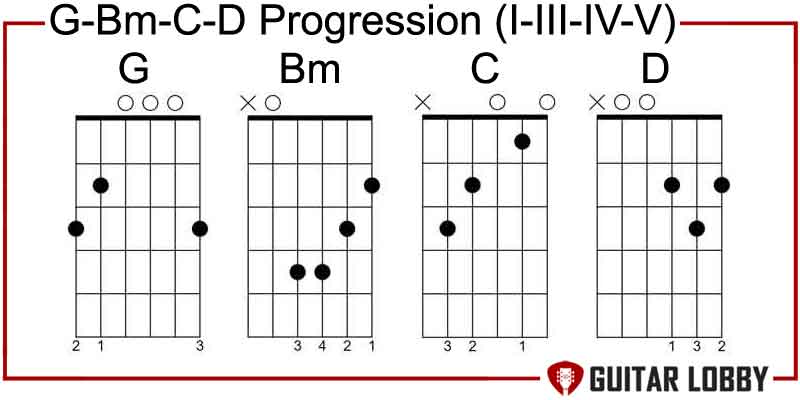
Here’s a well-established chord sequence found in rock ballads as well as jazz and pop. If you know your barre chords, there’s nothing that can stop you from acing the I – iii – IV – V. In the key of G major, the sequence looks like G – Bm – C – D. This means you start with G major, then move to the B minor barre chord before playing C major and D major chords.
Notice how the root notes form a 3-4-5 bass ascending bass line progression. And here’s why it’s interesting: After the era of the doo-wop, the vi chord found itself being increasingly replaced by the minor third chord as it blended brilliantly with 1-4-5.
You can sample this chord progression in the chorus of “I Feel Fine” by the Beatles. If we were to apply this progression in the key of E major, it would be E – G#m – A – B. Meanwhile, in the scale of C major, this sequence would be C – Em- F – G.
Popular Songs That Use This Progression: “Crocodile Rock” (Elton John) and “I Feel Fine” (The Beatles).
14. D – A – Bm – F#m – G – D – G – A Progression I – V – vi – iii – IV – I – IV – V
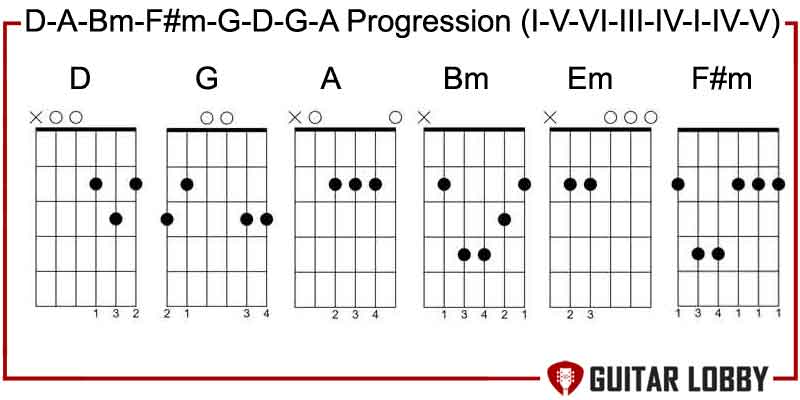
Don’t let this eight-chord progression overwhelm you! It’s basically an extension of the ubiquitous I – IV -V progression but with more movement. Also known as Pachelbel’s Canon, the talent behind this chord sequence was a 17th-century German Baroque composer Johann Pachelbel.
Till the 1970s, the use of Pachelbel’s progression was largely limited to classical music and was more or less forgotten. But a 1968 arrangement by French conductor Jean-François Paillard managed to remind the musical world what they were missing out on. Suddenly the pop tunes of the ‘70s started using this sequence, and this carried on till the early 2000s. In other words, there are plenty of earworms that tap into Pachelbel’s suddenly re-emerged in the ‘70s and ‘80s, as well as pop earworms.
What I love most about this progression is that it sounds as amazing on a nylon string as an acoustic. In the key of D major, this progression goes as D – A – Bm – F#m – G – D – G – A. Play this sequence for anyone who has grown up in the ‘80s and ‘90s, and you’ll see them swept away by a wave of nostalgia.
Popular Songs That Use This Progression: “Canon in D Major,”; “Basketcase” (Green Day), “Don’t Look Back in Anger” (Oasis).
15. C – F – G – F Progression I – IV – V – IV
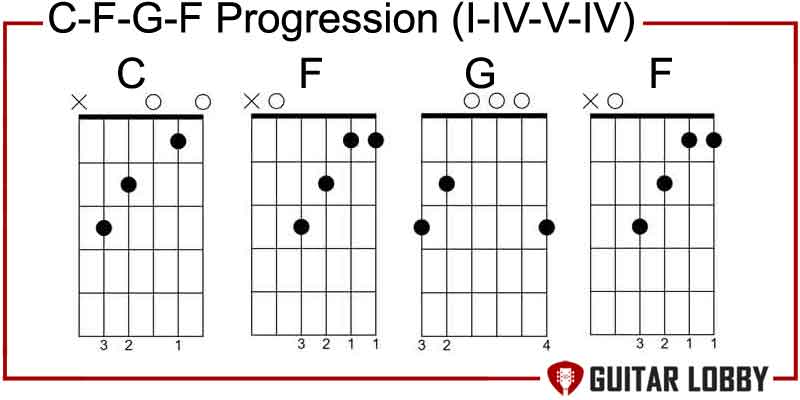
Another universal chord sequence that every guitarist should know about. If you’ve figured out the I – IV – V, this should be in your arsenal in no time. It’s no accident that so many tracks use the I – IV -V – IV. There’s a sense of completion, satisfaction, and happiness brought about by the IV chord going back to the I chord.
If you know how to play the F chord as a barre chord, the transition becomes smoother as both the chords have the ring finger in the same position. It lets you pivot to bring more flair to your chord switching. F to G transition is a bit trickier and may require lots of practice. After you’ve made the F chord, move the ring and the pinky to the first and second strings. Next, place the first two fingers on the bottom two strings. When going back from G to F, use the first finger to barre the first fret, then get the rest of the fingers in position to form the F chord. While this is just a pro tip, I recommend using whatever switching order as long as it comes intuitively to you. The key is to be consistent and comfortable, and the order that works for me may not work for you.
So, you see, this is a fairly easy chord sequence for beginners once you’ve learned to make cleaner switches. You can hear this progression in famous records by musical bigwigs. Here’s a list of songs you can tune into to familiarize yourself with this progression.
Popular Songs That Use This Progression: “Sweet Home Alabama” (Lynyrd Skynyrd); “Leaving on a Jet Plane” (John Denver); “Brown Eyed Girl” (Van Morrisson).
Wrapping Up:
By now, you must’ve already seen how progressions can be used to build tension and give resolution. But you may have also seen that many songs with the same chord progression don’t sound exactly alike. That’s where different keys and notes come into play. Once you’ve mastered a few on this list, why not experiment with different keys and strumming patterns to create your own unique melodies? And maybe even share some of those progressions with us in the comments section below!

My name is Chris and I’ve had a passion for music and guitars for as long as I can remember. I started this website with some of my friends who are musicians, music teachers, gear heads, and music enthusiasts so we could provide high-quality guitar and music-related content.
I’ve been playing guitar since I was 13 years old and am an avid collector. Amps, pedals, guitars, bass, drums, microphones, studio, and recording gear, I love it all.
I was born and raised in Western Pennsylvania. My background is in Electrical Engineering, earning a Bachelor’s degree from Youngstown State University. With my engineering experience, I’ve developed as a designer of guitar amplifiers and effects. A true passion of mine, I’ve designed, built, and repaired a wide range of guitar amps and electronics. Here at the Guitar Lobby, our aim is to share our passion for Music and gear with the rest of the music community.
